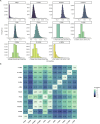Exploring inbreeding depression in Brazilian Angus cattle population using pedigree and genomic data
- PMID: 40552011
- PMCID: PMC12183215
- DOI: 10.3389/fgene.2025.1613820
Exploring inbreeding depression in Brazilian Angus cattle population using pedigree and genomic data
Abstract
Introduction: Inbreeding depression refers to the decline in performance caused by increased levels of inbreeding, which results from mating individuals with common ancestors. This study aimed to estimate inbreeding coefficients based on both pedigree and genomic information using six different metrics and evaluate, the inbreeding depression on different traits officially evaluated by the Brazilian Angus Association.
Material and methods: A total of 13,777 genotyped animals, imputed to a density of 78,837 SNPs, and 530,327 animals in the pedigree file, extending up to 17 generations, were used in the analysis. The inbreeding metrics evaluated included: pedigree-based inbreeding (FPED), genomic relationship matrix-based inbreeding (FGRM), observed vs. expected homozygosity (FHOM1), genotyped homozygosity (FHOM2), correlation between uniting gametes (FUNI), and runs of homozygosity (FROH). Traits related to growth, conformation, meat quality, reproduction, resistance to ectoparasites, and heat stress were analyzed.
Results: The results revealed a range of inbreeding coefficients, with inbreeding estimated using ROHs showing the highest values (0.13). The impact of inbreeding on various traits was predominantly negative, with significant inbreeding depression observed for traits such as hair coat. Some traits, such as intramuscular fat and birth weight, had positive associations with inbreeding, indicating a complex trait-specific relationship. Shorter ROH segments (<2 Mb) generally had smaller or beneficial effects compared to longer ROH segments (>16 Mb).
Discussion: These findings underscore the complexity of inbreeding depression and highlight the importance of considering both the extent and historical depth of inbreeding when evaluating its effects on various traits. Overall, this research provides valuable insights into the genetic basis of inbreeding depression in the Brazilian Angus population and demonstrates the usefulness of genomic data in understanding and mitigating the impacts of inbreeding in livestock populations.
Keywords: animal breeding; genetic diversity; genomic inbreeding; genomic relationship matrix; genomic selection; livestock genetics; quantitative traits.
Copyright © 2025 Mulim, Campos, Cardoso and Rojas de Oliveira.
Conflict of interest statement
Author FC was employed by Brazilian Agricultural Research Corporation. The remaining authors declare that the research was conducted in the absence of any commercial or financial relationships that could be construed as a potential conflict of interest.
Figures


Similar articles
-
Exploring genetic diversity and genomic inbreeding across local beef cattle breeds.Animal. 2025 Jul;19(7):101565. doi: 10.1016/j.animal.2025.101565. Epub 2025 Jun 5. Animal. 2025. PMID: 40580843
-
Impact of increased heterozygosity on Nordic Total Merit traits in dairy cattle: Potential for mating strategy optimization.J Dairy Sci. 2025 Jul 15:S0022-0302(25)00446-1. doi: 10.3168/jds.2024-26200. Online ahead of print. J Dairy Sci. 2025. PMID: 40675474
-
Inbreeding patterns and genetic diversity under selection in Teha sheep.Front Genet. 2025 Jun 27;16:1576125. doi: 10.3389/fgene.2025.1576125. eCollection 2025. Front Genet. 2025. PMID: 40656594 Free PMC article.
-
Signs and symptoms to determine if a patient presenting in primary care or hospital outpatient settings has COVID-19.Cochrane Database Syst Rev. 2022 May 20;5(5):CD013665. doi: 10.1002/14651858.CD013665.pub3. Cochrane Database Syst Rev. 2022. PMID: 35593186 Free PMC article.
-
Cost-effectiveness of using prognostic information to select women with breast cancer for adjuvant systemic therapy.Health Technol Assess. 2006 Sep;10(34):iii-iv, ix-xi, 1-204. doi: 10.3310/hta10340. Health Technol Assess. 2006. PMID: 16959170
References
-
- Campos G. S., Cardoso F. F., Gomes C. C. G., Domingues R., de Almeida Regitano L. C., de Sena Oliveira M. C., et al. (2022). Development of genomic predictions for Angus cattle in Brazil incorporating genotypes from related American sires. J. Anim. Sci. 100, skac009–13. 10.1093/jas/skac009 - DOI - PMC - PubMed
LinkOut - more resources
Full Text Sources
Miscellaneous

